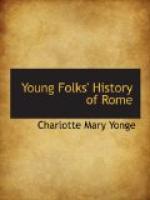Vespasian was an upright man, and though he was stern and unrelenting, his reign was a great relief after the capricious tyranny of the last Claudii. He and his eldest son Titus were plain and simple in their habits, and tried to put down the horrid riot and excess that were ruining the Romans, and they were feared and loved. They had great successes too. Britain was subdued and settled as far as the northern hills, and a great rising in Eastern Gaul subdued. Vespasian was accused of being avaricious, but Nero had left the treasury in such a state that he could hardly have governed without being careful. He died in the year 79, at seventy years old. When he found himself almost gone, he desired to be lifted to his feet, saying that an Emperor should die standing.
[Illustration: VESUVIUS PREVIOUS TO THE ERUPTION OF A.D. 63.]
He left two sons, Titus and Domitian. Titus was more of a scholar than his father, and was gentle and kindly in manner, so that he was much beloved. He used to say, “I have lost a day,” when one went by without his finding some kind act to do. He was called the delight of mankind, and his reign would have been happy but for another great fire in Rome, which burnt what Nero’s fire had left. In his time, too, Mount Vesuvius suddenly woke from its rest, and by a dreadful eruption destroyed the two cities at its foot, Herculaneum and Pompeii. The philosopher Plinius, who wrote on geography and natural history, was stifled by the sulphurous air while fleeing from the showers of stones and ashes cast up by the mountain. His nephew, called Pliny the younger, has left a full account of the disaster, and the cloud like a pine tree that hung over the mountain, the noises, the earthquake, and the fall at last of the ashes and lava. Drusilla, the wife of Felix, the governor before whom St. Paul pleaded, also perished. Herculaneum was covered with solid lava, so that very little could be recovered from it; but Pompeii, being overwhelmed with dust or ashes, was only choked, and in modern days has been discovered, showing perfectly what an old Roman town was like—amphitheatre, shops, bake-houses, and all. Some skeletons have been found: a man with his keys in a cellar full of treasure, a priest crushed by a statue of Isis, a family crowded into a vault, a sentry at his post; and in other cases the ashes perfectly moulded the impression of the figure they stifled, and on pouring plaster into them the forms of the victims have been recovered, especially two women, elder and younger, just as they fell at the gate, the girl with her head hidden in her mother’s robe.




